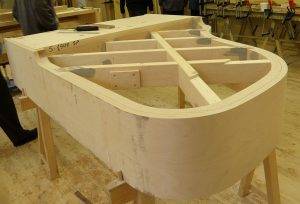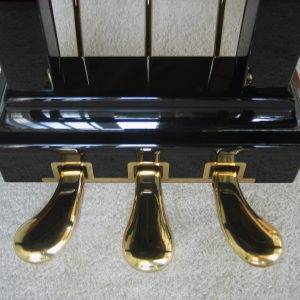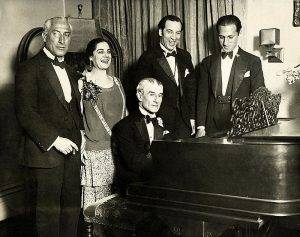Piano
Piano is an acoustic instrument. Invented by Bartolomeo Christofori in 1700 (exact year unknown) in which strings are struck with a hammer. The instrument is played by a keyboard with the fingers or toes. Sixty presses both keys to hammer the strings and play a melody. The word piano stands for the Italian word forte piano, which the early piano models were known by in 1700. The word piano means Soft and the word forte means loud. The amount of sound produced by this instrument depends on the amount of pressure the pianist’s finger has on the key: the higher the pressure on the key, the higher the hammer pressure and the louder the sound produced.
– Comparison
The piano is opposite the harpsichord, because the volume produced in the harpsichord, unlike the piano, is not variable and the volume produced is limited and constant.
The first forte pianos in the 1700s had a quieter sound and a smaller dynamic range. The acoustic piano usually has a wooden protector around the keyboard and metal strings. Pressing one or more keys on the keyboard causes the hammer to hit the wires. The hammer returns to its original position after hitting the wire. And the wires continue to vibrate at their resonant frequency. These vibrations are transmitted across the bridge to the soundboard, which amplifies the acoustic energy. When the switch is released, the damper stops the vibration of the wires and ends the sound or so-called muffle. Even by removing the fingers from the key, the notes can be held up using the pedal.
– Resonance pedal
The reverberation pedal allows pianists to play pieces that are impossible to play. You can use this pedal to hold the note And start playing the melody with your hands at the same time. Unlike reeds and harpsichords (which were widely used before the invention of the piano), the volume of sound produced in them is limited. The higher the pressure of the finger on the key, the louder the sound.
– The second comparison
Most modern pianos have 88 keys. 52 white keys for C, D, E, F, G, A and B and 36 black keys above the white keys.
This means that with the piano you can play 88 different steps (or “different notes”).
The black keys are (F♯ / G ♭, G♯ / A ♭, A♯ / B ♭, C♯ / D ♭, and D♯ / E ♭).
Rarely do some pianos have extra keys (which require extra strings). Most notes have three strings, with the exception of the bass, which has one to two strings. The strings sound when pressed or tapped, and are muffled by dampers when the hands are removed from the keyboard.
– Although acoustic pianos
Although acoustic pianos have strings, they are classified into percussion instruments because they are played in the same way as the piano spin and the harpsichord.
In the Hornbostel Sachs musical instrument classification system, the piano is considered a stringed instrument.
There are two types of pianos: grand and vertical piano.
Grand Piano
Piano Grand is used for classical solos, chamber music (a group of musicians playing in a small group) and often in jazz and pop concerts.
Vertical piano
Vertical piano is the most popular type of piano because its size is more suitable for use in private homes and home practice. During the 1800s, under the influence of musical trends in the Romantic period, innovations such as cast iron frames made the piano sound louder, more stable, and louder. In the nineteenth century, the piano played the same role as a radio. Or the gramophone played in the twentieth century.
– Example
When a family in the nineteenth century wanted to hear a newly released piece of music or a symphony. They could hear the music from the piano of a family member who could play the piano. The instrument has been widely acclaimed in jazz, classical, traditional, solo, solo and composition groups.
Although the piano compared to other musical instruments such as:
Acoustic guitars are heavy, portable and expensive, but many musicians and amateurs are trained to play the piano. And its widespread availability in theaters, schools and rehearsal spaces has made it one of the most popular musical instruments in the West.
Electric pianos with sound amplifiers (1929), electronic pianos (1970), and digital pianos (1980) were also developed.
Electric piano became very popular in the 1960s and 1970s in funk, jazz and rock styles.
– History of the piano
In the old days, the organ was used by the people. Instrument makers thought of designing a keyboard. The first musical instrument in which strings were used. Dolsimer is a hammer that has been used in Europe since the Middle Ages. During the Middle Ages, manufacturers tried several times to design a keyboard that used wire. In the 17th century, keyboards and harpsichords with keyboards were developed.
In the harpsichord, by pressing the key, through the mechanical system and the percussion, the strings vibrate and sound is produced, but in the clavichord, the tangent strikes the strings and the sound is produced.
After centuries of effort and study on the harpsichord, manufacturers were able to invent a soundboard, a bridge, and a mechanical system for keyboards.
– Inventor of the piano
This instrument was invented by Bartolomeo Cristofori (1655-1731) from Padua, Italy. Christopher’s specialty was the production of harpsichords. He used his knowledge of the harpsichord keyboard to make the first piano. The exact year of production of this instrument is not known. Some documents consider the year 1700 as the year of piano production and others as the year 1698. Three pianos from the 1720s are still available. Their old name is Piashno Forte, which was later renamed the piano for simplicity.
– Sound comparison
The sound of the keyboard instrument is very slow to play in large halls. The harpsichord produces a very loud sound, but with it you can not have good control over every note.
A harpsichord can not produce different levels of music even if the musician uses all his skills. Piano performance is much better than keyboards and harpsichords. It has both a loud voice and a capable musician
Components:
Frame (2) Door, front part (3) Capo door (4) Damper (5) Door, back part (6) Damper mechanism (7) Sustenoto rail (8) Pedal mechanism, rods) 9,10,11)
Pedals: Right (Resonator / Damper) Middle (Sostenoto), Left (Soft / Soft Pedal) (12) Bridge (13) Wireless (14) Frame (15) Sandboard (16) Wire
Pianos can have more than 12,000 separate sections and support six functional features:
Keyboard, hammer, damper, bridge, soundboard and wire. Many piano pieces are made of materials that are durable and long lasting.
Especially frames that are usually made of maple and beech wood. According to Harold Colin, the purpose of a solid frame is to
Vibrational energy remains as long as possible in the soundboard and wire and is not wasted by scattering in other parts.
Piano frame
They are usually made of thin sheets of wood and are therefore flexible and can be bent as desired immediately after gluing. Theodore Steinweider was developed in 1880 to reduce production time and cost. Prior to this, piano frames were made of several pieces of solid wood veneer and joined together, and European manufacturers made good use of this method in the twentieth century.
With the exception of an Austrian manufacturer (Bossendorfer) who made the frame from poplar wood, the same wood that the soundboard is made of, which makes the frame resonate with the soundboard and produce a better sound.
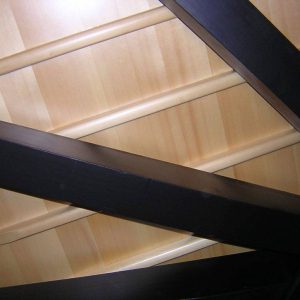
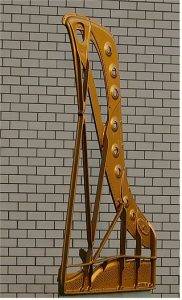
Harp or metal frame is usually made of cast iron. Because the wires vibrate on both sides, an inadequate large screen absorbs a large amount of vibrational energy that must travel across the bridge toward the soundboard.
While some builders use cast steel, others prefer cast iron. Cast iron has enough flexibility to use a piano. It is much more resistant to deformation than steel and is particularly resistant to high pressure.
Casting a plate is an art because its dimensions are vital and iron is reduced by about one percent during cooling.
– Aesthetically
The inclusion of a very large piece of metal in the piano is potentially an aesthetic. The creators polish these pages, paint and decorate them, and finally hack their name on the page.
In an effort to make lighter pianos, Alka worked with piano makers and piano companies in the 1940s to make these plates from aluminum. Aluminum plates were no longer widely accepted and were no longer produced.
Many parts of piano action are generally made of wood, such as maple, beech and hornbeam, but since World War II, piano makers have also used plastic.
– Plastics
Plastics, which were used in some pianos in the late 1940s and 1950s, were no longer used in piano making after decades of use.
In early 1961, New York’s Stanley used Teflon to make some piano pieces, but in 1982 Teflon was no longer used due to friction and wear. The property of Teflon is that it is resistant to moisture. But wood is not durable and eventually causes problems. Recently, Kawai made piano components from newer materials such as carbon fiber plastic, and manufacturers of piano components, including Mr. Wessel, Nickel, and Grass, have launched a new product line. Over time, it becomes clear whether these parts made of carbon fiber plastic are as durable as wood parts.
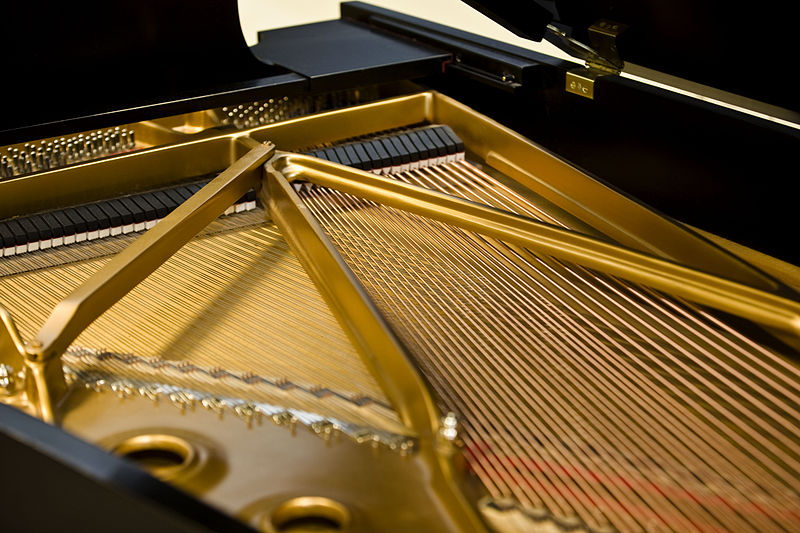
Harp or metal frame is usually made of cast iron. Because the wires vibrate on both sides, an inadequate large screen absorbs a large amount of vibrational energy that must travel across the bridge toward the soundboard.
While some builders use cast steel, others prefer cast iron. Cast iron has enough flexibility to use a piano. It is much more resistant to deformation than steel and is particularly resistant to high pressure.
Casting a plate is an art because its dimensions are vital and iron is reduced by about one percent during cooling.
– Aesthetically
The inclusion of a very large piece of metal in the piano is potentially an aesthetic. The creators polish these pages, paint and decorate them, and finally hack their name on the page.
In an effort to make lighter pianos, Alka worked with piano makers and piano companies in the 1940s to make these plates from aluminum. Aluminum plates were no longer widely accepted and were no longer produced.
Many parts of piano action are generally made of wood, such as maple, beech and hornbeam, but since World War II, piano makers have also used plastic.
– Plastics
Plastics, which were used in some pianos in the late 1940s and 1950s, were no longer used in piano making after decades of use.
Even in the poorest pianos, the board is made of poplar wood. The best piano makers use a quarter of a ring of wood to make it, and before making a soundboard, they dry the wood for a long time. From the same wood in the soundboard Guitars are also used. In cheap pianos, plywood is used. The design of the piano hammer should be such that the hammer lands as low as possible so that it does not make too loud a sound. The hammer should be light enough to move quickly when a key is pressed; And at the same time it must be strong enough. Hit the strings hard enough as long as the musician presses the key, especially to play and make louder sounds that the musician plays loudly.
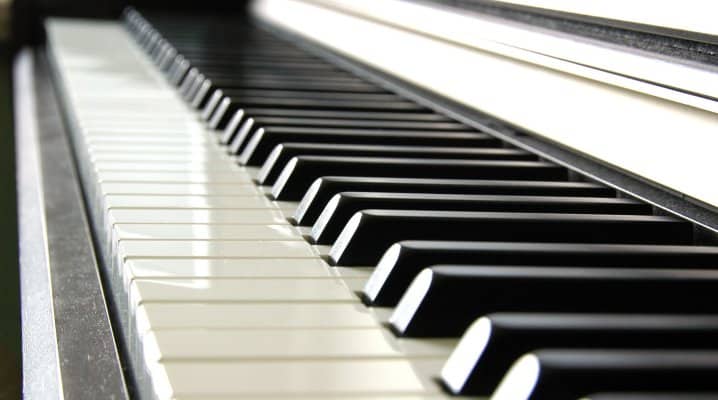
In the early years of construction, these keys were usually made of sugar pine. In 2010, they were usually made of spruce or bass wood. Snubs are commonly used in high quality pianos. Black keys are traditionally Made of ebony Budo, the white keys were covered with ivory strips. Since ivory species are endangered and protected, manufacturers use plastic instead of ivory. In some countries, species are slaughtered and hunted. Dentin is illegal, but dentin is still found in limited quantities.
– Replacing plastic with dentin
Yamaha has invented a plastic called Ivorite that claims to look and feel like ivory. Since then, other builders have imitated them.
– Number of buttons
Almost every modern piano has 52 white keys and 36 black keys, for a total of 88 keys.
(Seven octaves, from A0 to C8).
Many older pianos have only 85 keys (seven octaves from A0 to A7)
Some manufacturers of this instrument have expanded its range to one or both sides.
The Imperial Bösendorfer piano, for example, has 9 extra keys at the end of the bass, offering a total of 97 keys and an eight-octave range.
These extra keys can be hidden under a small door so that unskilled pianists do not have visual disturbances, or the color of the extra white keys can be reversed (or, conversely, the color of the black keys can be reversed).
Recently, piano maker Stewart and Swans have developed pianos with 108 keys from c0 to B8 and 9 octaves. The extra keys are the same as the other keys in appearance.
(Not hidden) These extra keys are actually to increase the resonance of the connected wires.
– Damper pedal
In other words, when the damper pedal is depressed, the wires vibrate simultaneously with the other wires, resulting in a fuller sound.
Only a handful of songs written for the piano use these extra notes.
– Types of pianos in terms of the number of buttons
Schoenhut has built the grand piano and vertical piano in the toy piano with only 44 to 49 keys, reducing the distance between the keyboard and the pedal.
These pianos are actually real pianos and not toys. There is a rare type of instrument that has a dual keyboard called the Emánuel Moór piano forte.
This piano was invented by the Hungarian composer and pianist Emánuel Moór (February 1863 – October 20, 1931).
The piano consisted of two keyboards, one above which was one. The lower keyboard has 88 regular keys and the upper keyboard has 76 keys.
When you press the upper keypad, the internal key mechanism activates the same lower keypad, but one octave higher.
This allows the pianist to access two octaves with one hand, which is impossible on a regular piano.
– Works played with this type of piano
Dual keyboard music works originally for harpsichord, such as:
Gold leaf variations were made by Bach and it became much easier to play with this type of piano. In this design, there is a fourth pedal
It works for both up and down keyboards so when
– Continues :
You play with the lower keyboard, the note is played one octave more.
Only 60 of these pianos were made by Bossendorfer. Other manufacturers such as:
Bach Stein, Chickering, Steenoy, and Swans also produced small numbers.
Pianos are made with keyboard replacement systems such as the Janko keyboard.
How many pedals do pianos have?
In the 18th century, instead of pedals, there was a lever on the pianos that was brought up with the help of the musician’s knee.
Most grand pianos in the United States have three pedals:
Soft pedal, Sostenoto pedal and resonant pedal (left to right, respectively)
While in Europe, there are two pedals on pianos:
Resonant pedal and soft pedal. Most modern vertical pianos have three pedals:
Soft pedals, practice pedals and resonant pedals, but older or cheaper pianos may not have exercise pedals.
In Europe, the standard pedal number for vertical pianos is two pedals: soft and resonant pedals.
– Resonance pedal
The resonant pedal (or damper pedal) is often referred to simply as the “pedal” because it is the most commonly used pedal.
This pedal raises all the keys and preserves the notes played. In addition, it corrects the overall sound created throughout the wires. Also, when the piano strings vibrate, this pedal synchronizes the vibration of the strings.
For example, if a musician plays the A note at 440 Hz, the higher octaves of the A note also harmonize.
Soft pedal The soft pedal is located to the left of the pedals. This pedal moves the hammers so that they only hit two or three strings. Old pianos were designed so that the hammers were only on one string. This is why it is called the una corda soft pedal.
This pedal is used to mute and soften the tone that is not used in vertical pianos. This pedal brings the hammers closer to the wire to hit the wire with less kinetic energy.
– Sustenoto pedals on grand pianos
In grand pianos, the middle pedal is the Sostenoto pedal. Holds all dampers high when this pedal is depressed. This pedal allows the musician to hold the note by pressing this pedal while the player’s hands are free to play other notes.
This pedal is very useful for playing a fixed track with low bass. In many vertical pianos, the middle pedal is known as the practice pedal. This pedal muffles the sound very slowly or so-called.
On some non-standard pianos, the center pedal resonates when the dampers are lifted only from the wires at the bass.
Musicians use this pedal to maintain a bass note or a string.
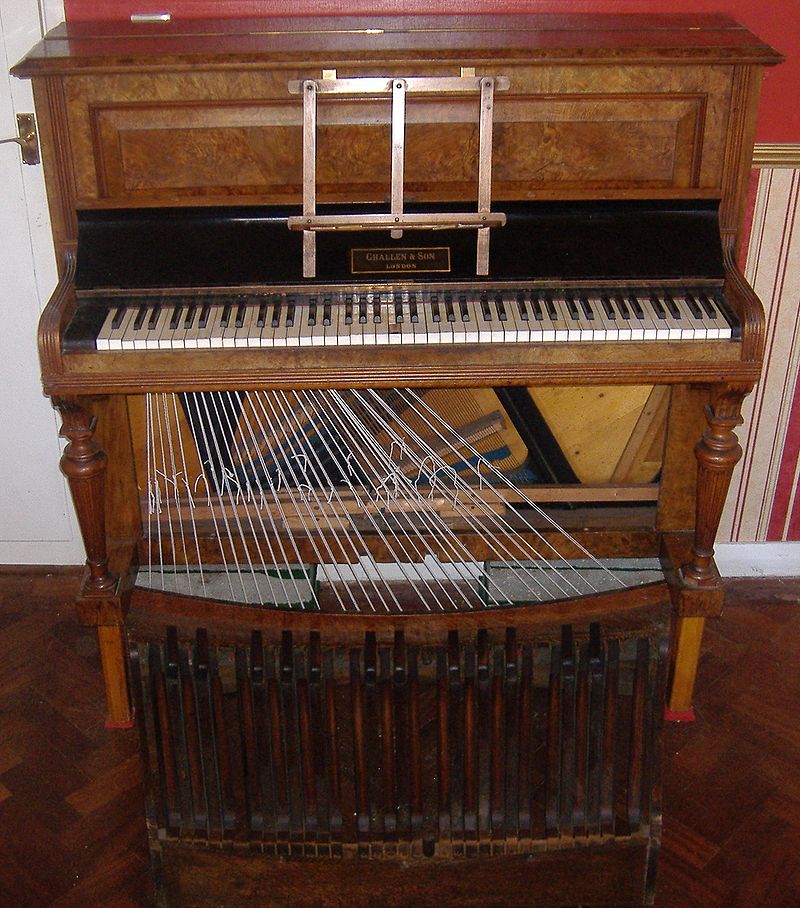
(Example by Irving Berlin) is a rare piano. It has a center pedal that acts as a clutch that separates the keyboard from the mechanism, so the musician can move the keyboard left or right with a lever. The piano changes the whole action of the piano, so the pianist can play music with one key so that it looks like another key.
Some piano manufacturers have an extra pedal in addition to the standard number of two or three pedals.
Stewart and Swans pianos as well as the largest Fazioli piano have a fourth pedal to the left of the three main pedals.
The function of this fourth pedal is similar to that of a soft pedal on a vertical piano.
Crown Company
Crohn & Schwart produced four-pedal pianos. Wing and Sun introduced a five-pedal piano in New York in the 1920s.
From left to right, the pedals are mandolin, orchestra, expression, soft, forte (resonant). The orchestra pedal produces a sound similar to that of the guitar, mandolin, banjo, dulcimer, and harp, hence the name orchestra.
The mandolin pedal uses a similar method. The orchestra pedal produces an echo sound similar to that played in an orchestra hall.
Pedal piano is a rare type of piano that includes a pedal board so that musicians can play with their feet.
There are two types of pedal pianos, one of which has the same mechanism and function as a handheld keyboard. In the second type, which is a rare model, it consists of two independent pianos (each with separate mechanics and strings), one on top of the other, one for playing with the hands and the other for playing with the feet.
This device was originally made as a training device for organ musicians.
– Instrumentation (mechanics)
When the key is pressed, a chain reaction is generated to produce sound. First, the key activates the Vipen mechanism, which triggers
Lift the wooden rod of the hammer and lower it to the wire. The switch also raises the damper and immediately after the hammer strikes the wire
The hammer returns to its original position, causing the wire to vibrate and produce sound.
When the switch releases the damper to fall on the wire, the vibration of the wire stops and the sound is cut off. Vibrating wires do not produce loud sound on their own, but their vibrations are transmitted to a large sound keyboard that moves air and converts this energy into sound.
The irregular shape and intermediate junction cause these vibrations to oscillate at all frequencies.
– Piano hammer blow
The piano hammer lands on the piano strings. This means that when a pianist presses or hits a key, the hammer moves toward the strings. Pressing on the key does not control the hammer.
The damper keeps the note sound until the key is released. There are three factors that affect wire vibration:
Length: All factors are the same but the shorter thrust wire and the higher tuning frequency Mass per unit length: All other factors are the same but the wire is thinner and the tuning frequency is higher.
Stiffness: All other factors are the same, but the wire is stiffer and the higher the tuning frequency of the vibrating wire, it divides itself into many parts that are vibrating at the same time.
Each segment generates its own tuning frequency, which is called pure sound. Each vibrating wire has a sub-sound and a set of pure sounds.
The best combination of two tuning frequencies is when the frequency of one of them is twice the frequency of the other. For a wave repetition (consecutive wave), the velocity v is equal to the wavelength λ at frequency f:
v = λf
– tip
In piano strings, waves are reflected from both ends. This is why reflective waves lead to a standing wave pattern
But only for wavelengths λ = 2L, L, 2L / 3, L / 2,… = 2L / n where L is the length of the wire. Therefore, the only frequency produced in a wire is f = nv / 2L. The ring tone (sound) is mainly determined by the content of these harmonics (harmony).
Different instruments have different harmonic content for each tuning frequency. A real string vibrates in harmonics that are not perfect multiples of the sounds.
This leads to a slight inconsistency that strengthens the tone (sound), but also creates volume challenges throughout the piano.
– Press the piano key quickly
Pressing the piano key more quickly increases the amplitude of the waves and thus the sound. From low pp to high ff, the hammer speed changes almost a hundredfold.
The contact time of the hammer with the wire decreases from 4 milliseconds at pp to less than 2 milliseconds at ff. If two wires are tuned at the same tuning frequency and hit at the same time, the sound produced by another amplifier and a combined sound will be louder than the shorter duration.
If the vibration of one wire is not synchronous with another, they reduce each other and produce a softer sound over a longer period of time.
– Maintenance
Pianos are heavy and powerful instruments and at the same time delicate. Over the years, piano makers have developed special techniques for carrying both grand and vertical pianos to prevent damage to the mechanical elements of the piano.
Pianos should be tuned regularly. Piano hammers also need to be adjusted regularly to produce better sound. Pianos need regular maintenance to ensure that the hammers and key mechanisms work properly.
Worn pianos can be rebuilt by piano makers. The wires need to be changed regularly.
– Tune the piano
The relationship between two tuning frequencies is called a pause (distance), which is the ratio of their absolute frequency. Two different tuning frequencies are the same when their absolute frequencies are the same. The easiest pauses to identify, and the easiest pauses to adjust and tune, are those that have only one simple integer ratio.
The word temperament means tuning system, which regulates pauses (usually the fifth correct, which has a 3: 2 ratio).
In equal moderation, the fifth is tuned exactly with a slight compression. This tuning is achieved by slightly compressing the upper step or raising the lower step.
The multiplication ratio is equal to the frequency difference of each harmonic that exists for both tunes. Piano toners should use their ears well so that they can tune the piano instrument well.
Piano tuning should be in accordance with the frequency diagram (in which octaves are derived from doubling the frequency).
– Technique and how to play the piano
Like any other musical instrument, this instrument can be played through music written by the ear, or through improvisation.
The technique of playing this instrument has been different in harpsichord and clavichord and has evolved into a piano forte, and this evolution has continued until it has become modern and modern.
Changes in music styles and audience preferences in the 19th and 20th centuries, as well as the emergence of skilled artists with artistic tastes, have contributed to the evolution and growth of distinct approaches and training in playing this instrument.
Although this technique is often considered as a physical performance of a musical idea, many instructors and musicians of this instrument emphasize the physical, psychological and emotional aspects of this instrument.
Well-known approaches to the piano technique have been performed by: Dorothy Tobman, Edna Glandsey, Fred Karpoff, Charles Louis Hannon, and Otto Ortman.
– Performance styles
Many classical composers, including Haydn, Mozart, and Beethoven, have composed for Forte Piano, which is different from modern piano.
Forte piano has been a slower sounding instrument with a narrower dynamic range and smaller octaves.
Even composers of romantic songs, such as:
List, Chopin, Robert Schumann, Felix Mendelssohn, and Johannes Brahm composed much different songs for the modern piano from 2010 onwards.
Contemporary composers may use historical artwork from the 1600s to the 1800s to consider the difference in sound quality between old and new musical instruments and changes in performance and playing.
– Start playing professionally
When Beethoven began playing professionally in the 2000s, Forte became an instrument more closely resembling a modern piano.
Modern piano was widely used in the late nineteenth century. They had a larger octave range than the previous Forte.
About 30 more keys were added to the instrument, which expanded the amplitude of the bass to a deeper range and the amplitude of the subwoofer.
Mass production of pianos in the factory made it possible for middle-class people to buy at an affordable price.
– In the nineteenth century
In the nineteenth century in music halls and pubs
Dance groups or soloists were widely used.
Just as harpsichordists accompanied singers and dancers on stage from the late 1700s onwards, pianists took on the role in the following centuries.
During the nineteenth century, American musicians playing in pubs for working-class audiences, especially African American composers, developed new techniques in music based on modern piano.
Ragtime music composed by composers such as:
Scott Joplin has become popular, attracting a large audience until 1900. Jazz piano quickly gained popularity like reggae music.
– Techniques and rhythms
New techniques and rhythms for the piano were invented, including:
Boogie Vogue, Steinato (repetitive rhythm) and specialized sound engineering. George Groschen’s famous rhapsody combined American jazz piano with symphonic sounds, paving the way for the development of new music.
This technique is a technique for accompanying a jazz singer with a piano, which was inspired by the Duke Ellington technique. Ricky Tick’s music, which also played a different style of piano rhythm, became popular during this period.
Bipap techniques by leading pianists and composers such as:
Telonis Monk and Bad Powell grew along with jazz. In the late twentieth century, Bill Evans composed pieces of music using a combination of classical techniques and jazz experience.
In the 1970s, Herbie Hancock was one of the first jazz musicians to become very popular and introduced new musical techniques such as:
He used funk jazz and rock jazz. Piano is also prominent in rock, roll and rock music by artists such as:
Jerry Lee Lewis, Richard, Kate Emerson, Elton John
Ben Fold, Billy Joel, Nicki Hopkins, and Tory Education French pianist Maurice Ravel was born in 1928. From left to right:
Oscar Fried, singer Eva Gatier, Maurice Ravel (behind the piano), composer and musician Manue Lide Tedesco, and composer George Gershwin.
For the modern grand piano, modern styles of music by composers including:
Written by John Cage and Phillips Glass.
No doubt you have heard this sentence over and over again; Only sound remains. If you love music, you will surely admit that this sentence has some shortcomings and it can be completed as follows: only the beautiful sound and melody that remains. Sound and nova bring passion and life to the world. It is the human soul with music and music that flies and creates such salinity in it that nothing else in this world can create it. Yes, in order to be able to live and breathe in this world and in spite of all its misfortunes, we do not only need the climate and food, we also need the passion of life, the music, the sound, the music and the piano.
Magical piano maker
We want to break all the rules and regulations and shout recklessly. We call the piano one of the magic instruments. The sound that is heard from this instrument is so powerful that it can enchant you and separate you from time, place and material world without you wanting to. So it is not in vain that pianists have a penetrating and attractive word and look, they have borrowed this quality from the instrument in front of them and they can create you with their words, with their look and with the melody that they create with the piano. To enchant. Really, what better instruments than piano can be offered for magic?
You might think that we have exaggerated a bit about this instrument, but close your eyes for a moment and listen to its sound while a piano is being played. Even the molecules that are immersed in the air are thrilled to hear and listen to this sound, let alone the creature that from the beginning of its creation has mixed its life extract with nova, sound, tone and music. Music is inseparable from the human soul and world, and as long as he walks on this planet, the call for beauty is beautiful, and what is more worthy than the piano to be able to fulfill this desire.



